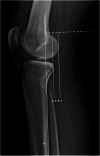No impact of graft size or time to surgery on anterior tibial translation under weight-bearing following ACL reconstruction
- PMID: 40052112
- PMCID: PMC11883484
- DOI: 10.1002/jeo2.70130
No impact of graft size or time to surgery on anterior tibial translation under weight-bearing following ACL reconstruction
Abstract
Purpose: The aim of this study is to evaluate the impact of graft size and time between injury to surgery (TBIS) on static anterior tibial translation (SATT) and dynamic anterior tibial translation (DATT) after anterior cruciate ligament (ACL) reconstruction.
Methods: A consecutive series of patients treated with primary ACL reconstruction using hamstring autograft was reviewed. Preoperative SATT, DATT and posterior tibial slope (PTS) were measured with a previously validated technique by two independent reviewers on lateral weight-bearing knee radiographs. Regression analysis was performed to assess the relationship between postoperative-preoperative SATT difference (Δ SATT) and postoperative-preoperative DATT difference (Δ DATT) with graft size and TBIS.
Results: In total, 66 patients were included in this study. The mean preoperative SATT and DATT were 2.41 (standard deviation [SD] 2.98) and 9.09 (SD 3.19), respectively. The mean postoperative SATT and DATT were 2.14 (SD 2.47) and 5.28 (SD 2.55), respectively. The mean graft size was 8.4 mm (SD 8.4; range 7.75-10), and the median TBIS was 3 months (range 1-275). Linear regression analysis showed no correlation between graft size and Δ SATT (p = 0.060) and Δ DATT (p = 0.979) and no correlation between TBIS and Δ SATT (p = 0.817) and Δ DATT (p = 0.811).
Conclusion: Our results suggest that larger graft sizes or shorter times between injury and reconstruction do not impact the reduction of SATT or DATT following ACL reconstruction.
Level of evidence: Level IV, retrospective cohort study.
Keywords: anterior cruciate ligament; dynamic anterior tibial translation; graft size; static anterior tibial translation; surgery time.
© 2024 The Author(s). Journal of Experimental Orthopaedics published by John Wiley & Sons Ltd on behalf of European Society of Sports Traumatology, Knee Surgery and Arthroscopy.
Conflict of interest statement
The authors declare no conflicts of interest.
Figures




Similar articles
-
Evaluation of Anterior Tibial Translation Under Physiological Axial Load After ACL Reconstruction With Lateral Extra-articular Tenodesis.Orthop J Sports Med. 2024 May 20;12(5):23259671241246111. doi: 10.1177/23259671241246111. eCollection 2024 May. Orthop J Sports Med. 2024. PMID: 38774385 Free PMC article.
-
A non-weight bearing protocol after ACL reconstruction improves static anterior tibial translation in patients with elevated slope and increased weight bearing tibial anterior translation.J Exp Orthop. 2023 Dec 20;10(1):142. doi: 10.1186/s40634-023-00694-w. J Exp Orthop. 2023. PMID: 38114884 Free PMC article.
-
Radiographic Investigation of Differences in Static Anterior Tibial Translation With Axial Load Between Isolated ACL Injury and Controls.Am J Sports Med. 2024 Feb;52(2):338-343. doi: 10.1177/03635465231214223. Epub 2024 Jan 3. Am J Sports Med. 2024. PMID: 38166410
-
A Radiographic Investigation Exploring Differences in Static Anterior Tibial Translation Expressed as a Percentage Between ACL-Deficient and -Intact Patients to Improve Interobserver Variability Between Different Centers.Orthop J Sports Med. 2025 Jun 2;13(6):23259671251330310. doi: 10.1177/23259671251330310. eCollection 2025 Jun. Orthop J Sports Med. 2025. PMID: 40470516 Free PMC article.
-
Considerations of the Posterior Tibial Slope in Anterior Cruciate Ligament Reconstruction: a Scoping Review.Curr Rev Musculoskelet Med. 2022 Aug;15(4):291-299. doi: 10.1007/s12178-022-09767-2. Epub 2022 Jun 2. Curr Rev Musculoskelet Med. 2022. PMID: 35653051 Free PMC article.
References
-
- Bernhardson, A.S. , Aman, Z.S. , Dornan, G.J. , Kemler, B.R. , Storaci, H.W. , Brady, A.W. et al. (2019) Tibial slope and its effect on force in anterior cruciate ligament grafts: anterior cruciate ligament force increases linearly as posterior tibial slope increases. The American Journal of Sports Medicine, 47(2), 296–302. Available from: 10.1177/0363546518820302 - DOI - PubMed
-
- Brazier, J. , Migaud, H. , Gougeon, F. , Cotten, A. , Fontaine, C. & Duquennoy, A. (1996) [Evaluation of methods for radiographic measurement of the tibial slope. A study of 83 healthy knees]. Revue de Chirurgie Orthopedique et Reparatrice de l'Appareil Moteur, 82(3), 195–200. - PubMed
-
- Cance, N. , Erard, J. , Shatrov, J. , Fournier, G. , Gunst, S. , Martin, G.L. et al. (2023) Delaying anterior cruciate ligament reconstruction increases the rate and severity of medial chondral injuries. The Bone & Joint Journal, 105–B(9), 953–960. Available from: 10.1302/0301-620X.105B9.BJJ-2022-1437.R1 - DOI - PubMed
-
- Da Costa, X. , Dan, M.J. , Cance, N. , Navarro, S. , Demey, G. & Dejour, D.H. (2024) Transtibial lateral meniscal root repair technique to appose remnant root with torn body: the double compression knot. Arthroscopy Techniques, 13(2), 102860. Available from: 10.1016/j.eats.2023.10.003. - DOI - PMC - PubMed
-
- Dan, M.J. , Cance, N. , Pineda, T. , Demey, G. & Dejour, D.H. (2024) Four to 6° Is the target posterior tibial slope after tibial deflection osteotomy according to the knee static anterior tibial translation. Arthroscopy: The Journal of Arthroscopic & Related Surgery, 40, 846–854. Available from: 10.1016/j.arthro.2023.07.007 - DOI - PubMed
LinkOut - more resources
Full Text Sources
Research Materials

